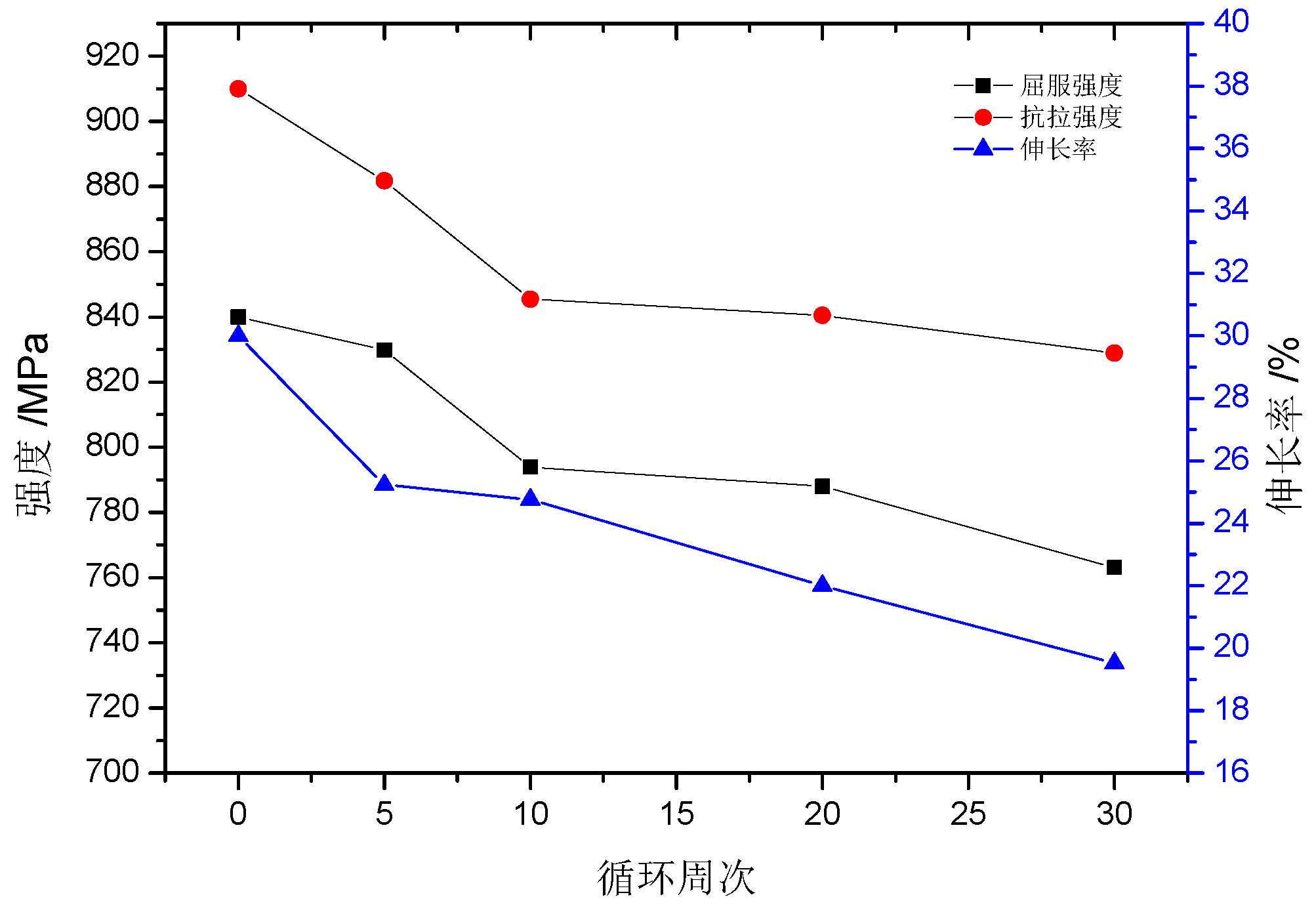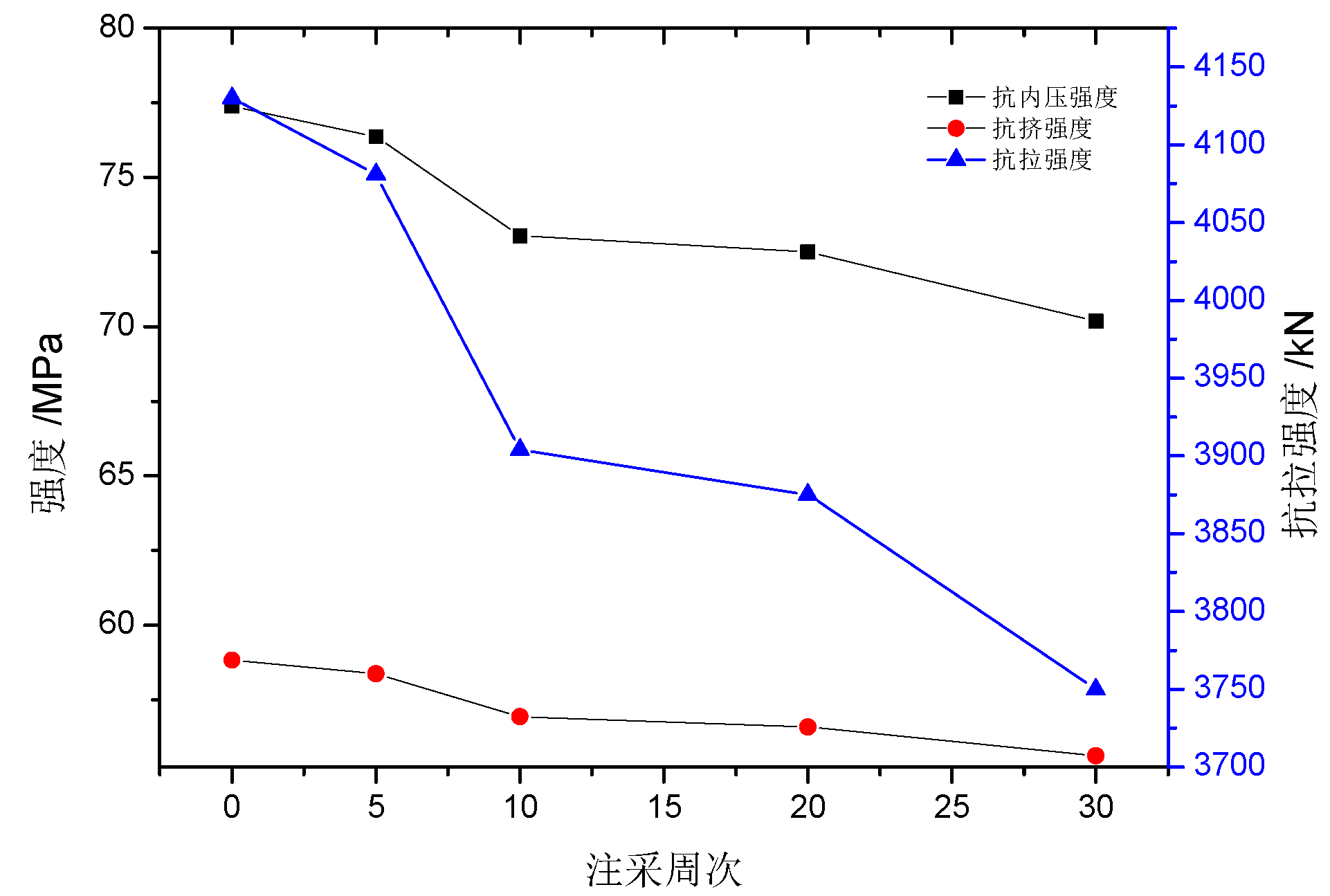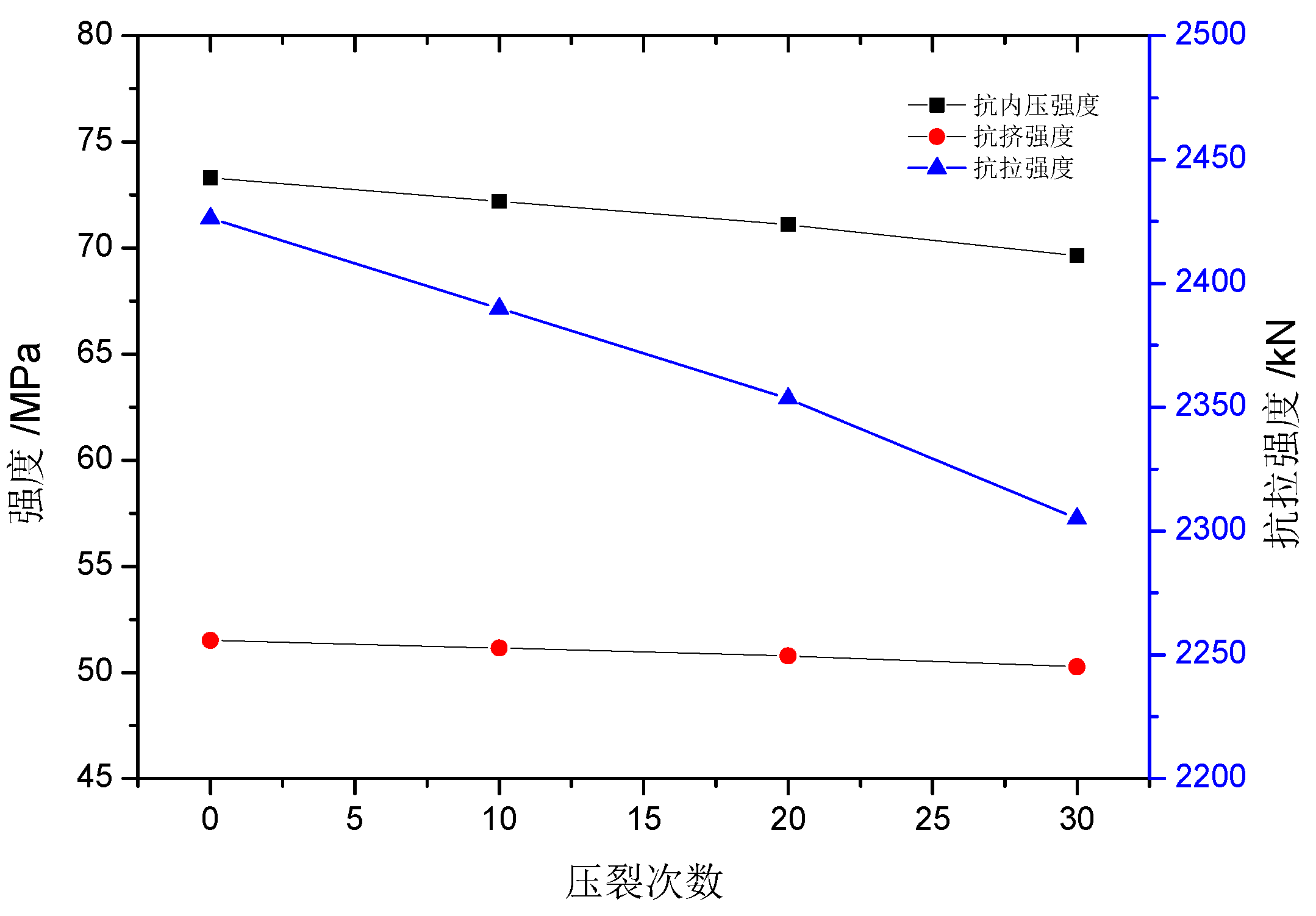Preprint
Article
Development of Design Method for Casing and Tubing Strings under Complex Alternating Loads
Altmetrics
Downloads
169
Views
29
Comments
0
This version is not peer-reviewed
Submitted:
02 May 2023
Posted:
02 May 2023
You are already at the latest version
Alerts
Abstract
In the increasingly complex environment of downhole working conditions such as frequent opening and closing of oil and gas wells, acidification/multi-stage fracturing, steam huff and puff, and strong injection and production, the traditional casing string design method standards based on strength design have gradually highlighted their limitations. It is necessary to formulate string design method standards that consider the full life cycle of wells such as drilling and completion, fracturing, and production operations. Starting from the analysis of the advantages and disadvantages of traditional casing string design methods, this paper presents the characteristics of the strain design methods and seal design methods that have been formulated for the life cycle of the string. The strain design method breaks through the traditional design concept and allows the design concept of controllable deformation of the pipe string. The sealing design method is currently the only standard method for the design of tubing strings. At the same time, it further proposes to consider the trend of pipe strength deterioration and establish a time dimension-based life cycle pipe string design method standard, which effectively solves the safety problem of pipe string design in production and operation.
Keywords:
Subject: Engineering - Safety, Risk, Reliability and Quality
1. Introduction
Due to the international low oil prices and the contradiction between supply and demand of oil and gas resources, The Ministry of Land and Resources of China has put forward the strategic policy of reducing cost and increasing efficiency for oil and gas field[1]. In view of the problems of harsh storage conditions, difficult exploitation, complex and variable load environment, and high casing loss rate in oil and gas wells such as low permeability well, deep well or ultra-deep well, offshore well and unconventional well[2], higher requirements are put forward for the design and evaluation methods of casing string, such as the cyclic dynamic load environment caused by frequent switching, acidizing, multistage fracturing, steam half and puff, strong injection and production[3,4]. At the same time, because the casing selection dose not highlight the difference of working conditions, the series of failures and hidden risks will further affect the safe production and operation of oil and gas, especially in high speed (100 million m3/day) gas storage injection-production wells[5].
Before the 21st century, the design standard of tubing string in oil and gas wells mostly focused on the strength design method of casing string, and mostly focused on the calculation and verification of static strength during drilling[6,7,8], and the design of tubing string was mainly based on numerical calculation without forming a standard design method[9]. At the beginning of the 21st century, scholars began to pay attention to the research on the design method of the whole life cycle of the pipe string, which covers the calculation of casing load and safety check in the process of drilling and production operation[10,11], and formulated the design standard of the string based on the strain design and sealing design[12,13], especially in the aspect of the tubing string for the first time.
This paper focuses on the characteristics and applicability of various casing string design methods, Discuss the gradual establishment of single strength design method of pipe string to strength+strain or strength+seal life cycle design method, In view of the complex and changeable working conditions in the well, the casing strength, sealing, deformation and other factors are comprehensively considered, and the design method of the full life cycle string considering the time dimension is further proposed.
2. Traditional casing string design method
The traditional casing string design method is mainly based on the strength design check, that is, the load on the casing string cannot exceed the casing strength, and the casing load is controlled within the elastic range. Traditional casing string design methods mainly include safety factor method, boundary load method, maximum load method, American AMOCO casing design method, German BEB casing design method, former Soviet casing design method and domestic casing string strength design method[14]. On this basis, the probabilistic reliability design method and the strength margin design method are further developed.
1.) Safety factor method
For a safe and economical design, the ratio of the strength of the casing against various external loads to the external loads on the casing must be equal to the specified safety factor. Because the axial load increases from bottom to top, and the extrusion pressure increases from top to bottom, the whole casing string should be composed of multiple sections of casing with different strength (determined by different steel grades and wall thickness) in order to achieve both safety and economy. The minimum safety factor of each section shall be equal to the specified safety factor.
2.) Boundary load method
The internal pressure and collapse resistance design method of this method is the same as that of the equal safety factor method. For the tensile design, the allowable strength calculated by the boundary load determined by the tensile strength and safety factor of the casing in the first section shall be used to select the following sections of casing. In this way, the boundary load between each casing section designed is the same, but not the same safety factor, which avoids excessive residual strength of the selected casing, reduces the total weight of the casing string, and makes the design result more reasonable and economic.
3.) Maximum load method
The casing string is designed according to the effective load of the casing string under the actual conditions and a certain safety factor. The biggest feature is that the external load calculation has been carefully considered. According to the classification of technical casing, reservoir casing and surface casing, the external load calculation methods of various types of casing are also different, so as to fully show the actual external load in the design.
4.) Former AMOCO casing design method in the United States
The former AMOCO company of the United States proposed two casing design methods, graphical method and analytical method, which have unique features in both load analysis and design methods. The impact of tensile stress is considered for both anti extrusion and internal pressure, and the shoulder force is considered when calculating external load.
5.) German BEB casing design method
German BEB Company has proposed a relatively complete set of casing design methods, whose main feature is to provide different calculation methods of external load in detail according to different casing types. For example, when calculating the collapse strength of a technical casing due to leakage, it is necessary to consider buoyancy, calculate the neutral point, and perform a double extraction stress calculation. The formation pore pressure value for collapse calculation should be based on the specific gravity of the mud at the time of casing; When calculating the internal pressure resistance, 40% of the kick volume is specified as the internal pressure basis, and 0.115 bar/m is selected as the formation pore pressure gradient; After the composite verification of anti-collapse and internal pressure resistance, the casing string structure is initially selected, and the tension check is conducted. Finally, the casing string structure is selected; Calculate the maximum test pressure at the wellhead while waiting for solidification.
6.) Casing design method in the former Soviet Union
The former Soviet casing design method provides formulas for calculating the internal and external pressures at various parts of the casing string during different periods and under different downhole operating conditions. When calculating the external pressure of the cementing section, the unloading effect of the cement sheath should be considered. The reduction of tensile strength against collapse under biaxial stress is not considered, but it is specified that when the tensile stress of the pipe body reaches 50% of the yield strength, the safety factor against collapse should be increased by 10%. The buoyancy of the drilling fluid is not considered when calculating the axial tension. When designing the technical casing, there are two methods: considering wear and not considering wear.
7.) Domestic casing string strength design method
In the 1980s, a group of old petroleum experts began to devote themselves to the study of domestic casing string strength design standards, absorbing advanced foreign practices, and in 1988, they formulated the "SY/T 5322-1988 Recommended Method for Casing String Strength Design". In 2002, they further improved and revised the "SY/T 5322-2002 Casing String Strength Design Method". After revising the casing string load calculation and strength calculation methods in 2008, "SY/T 5724-2008 Casing String Structure and Strength Design" [8] has been formulated in combination with other standards and has been used until now. This standard provides a unified set of casing design procedures, providing a selection method of basic parameters and relevant design conditions for the design, and the design method is gradually improved. However, there are still many disputes among domestic experts regarding the two-way stress calculation, strength calculation, and design methods in the new standard [15].
8.) Probabilistic reliability design method
Using the stress strength interference theory, it is assumed that the expected load and rated value of the design are functions of two random variables C and L (where C is the load capacity of the casing, and L is the estimated value of the maximum load during drilling). The design goal is to ensure that C is greater than L (C>L). The size of the probability P (C>L) is the probability of design success PS.
9.) Strength margin design method
The casing strength margin design must be studied using a combination of safety factor design methods for casing loads (such as the maximum load method) and probabilistic reliability design methods. That is, in the design of the casing string, the safety factor method is still used to determine the casing load, and the probability statistical method is used to study the distribution law of the casing strength performance to clarify the existence of strength margin in the casing. Then, the strength margin is used to reduce the safety factor in the design of the casing string. Then, reliability analysis is conducted on the casing string to ensure that the casing string remains reliable after reducing the safety factor, meet the use requirements, and ensure that the drilling cost is reduced.
3. Full Life Cycle String Design Method
The above traditional casing string design methods have their respective advantages and disadvantages, and should be comprehensively considered and optimized based on the actual operating conditions of the oilfield. However, these methods consider more drilling conditions and less production conditions. On this basis, considering changes in temperature and pressure during production, research and development have been conducted on full life cycle string design techniques such as strain-based casing string design methods for thermal recovery wells, and sealing design methods for gas storage injection production strings.
1). Design method of casing string for thermal recovery wells based on strain
The casing string design method for heavy oil thermal recovery wells includes casing string strength design and strain design [16]. That is, when performing casing string strain design for thermal recovery wells, the casing string strength design should be performed first, and then the casing string strain design should be performed. The strength design is to make the casing string meet the requirements of the drilling and completion process of heavy oil thermal recovery wells, and the strain design is to make the casing string meet the requirements of the production process of heavy oil thermal recovery. Therefore, the strain design of the casing string in heavy oil thermal recovery wells follows two design criteria: strength design criteria and strain design criteria.
The strength design criteria for the casing string are shown in Formula (1):
In the formula, is the working stress of the casing string, which is obtained by calculating the effective internal pressure, effective external pressure, and effective axial force (including bending stress) borne by the casing string according to SY/T 5724 standard; The allowable stress of the casing string is calculated according to ISO 10400 standard, and the internal pressure resistance, collapse resistance, and tensile strength of the casing string are divided by the internal pressure safety coefficient Si, collapse resistance safety coefficient Sc, and tensile safety coefficient St specified in SY/T 5724 standard.
The design criteria for casing string strain are shown in Equation (2):
In the formula,is the working strain of the casing string, %;is the allowable strain of the casing string, %;is the uniform elongation of the casing material, %; is the strain safety factor. This design method has formed the Chinese petroleum and natural gas industry standard "SY/T6952.1-2014 Thermal Recovery Well Casing String Based on Strain Design: Part 1 Design Method" [10].
2). Sealing Design Method for Injection Production String of Gas Storage
In the design of gas storage injection and production pipe strings, comprehensive consideration should be given to the alternating load caused by changes in parameters such as temperature, pressure, and flow. Especially in the design of pipe strings under alternating tensile/compressive loads, not only the structural strength design of the pipe string should be carried out, but also the sealing design of the pipe string should be carried out, that is, the design of the injection and production pipe string should be carried out from the perspective of structural strength and sealing integrity. In addition to the strength design criteria, the design of the injection and production string for gas storage should also follow the sealing design criteria. The strength design criteria cover the entire process of load and strength analysis such as tubing running, packer setting, annular pressure testing, and injection production operation. The sealing design criteria focus more on the bearing capacity of the string during the injection production alternating process. The sealing design criteria for injection production strings are shown in Equations (3) and (4):
In the formula, Fetmax is the maximum axial tensile load of the injection production string, N; Fecmax is the maximum axial compressive load of the injection production string, N; is the rated tensile strength of the injection production string, N; δt is the tensile efficiency of the injection production string joint under airtight sealing,%; δc is the compression efficiency under airtight sealing of the injection production string joint,%; Stt is the tensile safety coefficient of the joint under the gas seal of the injection production string; Stc is the safety factor against compression of the joint under the gas seal of the injection production string.
This design method has formed the Chinese petroleum and natural gas industry standard "SY/T 7370-2017 Recommended Practice for Selection and Design of Injection Production String for Underground Gas Storage" [11].
4. Design Method of Pipe String Based on Time Dimension
Under complex operating conditions such as multi-stage fracturing of unconventional oil and gas wells, multi cycle injection and production operations of gas reservoirs, deep natural oil and gas acid fracturing, and frequent well opening and closing, there are significant periodic pressure/temperature changes in the wellbore, which degrade the strength of oil and casing materials, further leading to a reduction in the service strength of the string. For example, after 30 weeks of injection and production operation in a gas storage, the test confirms that the yield strength of the injection and production string decreases by 9.2% after 30 weeks (Figure 1), resulting in a decrease of 9.20% in tensile strength, 9.30% in internal pressure strength, and 5.46% in collapse strength of the injection and production string, as shown in Figure 2; The casing material strength of a tight oil well also weakened during multistage fracturing. After 30 fracturing operations, the tensile strength, internal pressure resistance, and crush resistance of the 139.7mm×7.72mm P110 fracturing casing string decreased by 5.0%, 5.0%, and 2.43%, as shown in Figure 3.
The above full life cycle string design method has considered the load factors throughout the drilling and completion, pressure testing, and production processes, but does not consider the impact of strength changes. At the same time, it lacks a casing strength evaluation method under load/temperature coupling fluctuations, resulting in a reduction in casing strength margin during service, increasing production safety risks. Therefore, there is an urgent need to further study on this basis and establish a time dimension-based design method for pipe strings.
5. Conclusion
(1) The traditional casing string design method focuses on strength design, which should be comprehensively considered and optimized based on the actual operating conditions of the oilfield.
(2) The full life cycle string design method comprehensively considers drilling, completion, and production operating conditions, improving the accuracy and safety of string design, and forming corresponding industry design standards.
(3) The increasing complexity of downhole conditions, especially the increase in load cycles, has led to deterioration in the strength of oil and casing materials. It is necessary to further study and establish a full life cycle string design method and standard based on the time dimension.
References
- National Development and Reform Commission. Notice on the issue of Suggestions on accelerating the use of natural gas : NDRC energy [2017]1217[A/OL]. [2017-06-23].
- JIANG Tongwen, SUN Xiongwei. Development status and technology development trend of deep natural gas in China[J]. Oil Drilling & Production Technology, 2020, 42(5): 610-621. [CrossRef]
- HAN Lihong,YANG Shangyu,WEI Fengqi,YE Xinqun,WANG Jianjun,WANG Hang, PAN Zhiyong, ZHANG Huali, YUE Wenhan, XIE Bin, SHU Zhenhui, ZHANG Ping, LU Caihong, YIN Fei. Casing Deformation Mechanism and Controlling Method for Shale Gas Well Under Complex Fracture Environment[J]. Petroleum Tubular Goods & Instruments, 2020,6(04):16-23.
- Wang Jianjun, Sun Jianhua, Xue Chengwen, Han Jun, Zhang Guohong, Wang Rui.Optimization of gas-tight thread connectors on injection-production strings in underground gas storage wells[J].Natural Gas Industry, 2017, 37(05): 76-80. [CrossRef]
- Wang Jianjun, Lu Caihong, He Haijun, Sun Jianhua, Wu Xuehu,Li Fangpo.Selection and Evaluation of piping string in Underground Gas Storage with gas reservoirs[J]. Petroleum Tubular Goods & Instruments, 2019,5(02):26-29. [CrossRef]
- Han Zhiyong.Tubing string mechanics in hydraulic environment[M].Beijing: Petroleum Industry Press, 2011.
- . Gao Baokui & Gao Deli. A new method for testing tubing axial load in high-pressure and high-temperature wells[J]. Journal of the University of Petroleum, China, 2002, 26(2): 39-41.
- National Development and Reform Commission. SY/T 5724-2008 Design for casing string structure and strength[S]. Beijing: Petroleum Industry Press, 2008.
- Editorial Committee of offshore oil and gas field completion Handbook. Offshore well completion[M]. Beijing: Petroleum Industry Press, 1998.
- Yu Hao, Zhao Zhaoyang, Lian Zhanghua etc. Analysis on Wellhead Uplift by Tieback Casing String under Temperature Difference Effect[J]. China Petroleum Machinery,2022,50(1):100-107. [CrossRef]
- Chen Sheng,Fan Mingtao,Li Jun etc. Study on the Mechanical Behavior of Casing during Stimulated Reservoir Volume Fracturing [J]. China Petroleum Machinery, 2019,47(1):1-7.
- National Energy Administration. SY/T695.1-2014 Thermal casing string for strain based design Part1:Design method[S]. Beijing: Petroleum Industry Press, 2015.
- National Energy Administration. SY/T 7370-2017 Recommended practice for selection and design of the injection-production tubing string in underground gas storage well[S]. Beijing: Petroleum Industry Press, 2017.
- Drilling Handbook”preparation group. Drilling Handbook [M]. Beijing: Petroleum Industry Press, 2013.
- Han Zhiyong. Discussing on formula of tri-axial tension strength of casing string[J]. Journal of China University of Petroleum, 2011, 45(4): 77-80.
- WANC Jianjun. Steam stimulation wells casing string strain design and security technology research of shallow heavy oil[D]. Dongying: China University of Petroleum(Huadong),2015.
Figure 1.
Material properties of tubing after alternating tension and compression cycles.

Figure 2.
Service performance of tubing in different production periods.

Figure 3.
Service performance of Φ139.7mm×7.72mm P110 casing in different fracturing periods.

Disclaimer/Publisher’s Note: The statements, opinions and data contained in all publications are solely those of the individual author(s) and contributor(s) and not of MDPI and/or the editor(s). MDPI and/or the editor(s) disclaim responsibility for any injury to people or property resulting from any ideas, methods, instructions or products referred to in the content. |
© 2023 by the authors. Licensee MDPI, Basel, Switzerland. This article is an open access article distributed under the terms and conditions of the Creative Commons Attribution (CC BY) license (http://creativecommons.org/licenses/by/4.0/).
Copyright: This open access article is published under a Creative Commons CC BY 4.0 license, which permit the free download, distribution, and reuse, provided that the author and preprint are cited in any reuse.
MDPI Initiatives
Important Links
© 2024 MDPI (Basel, Switzerland) unless otherwise stated





